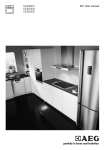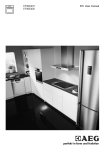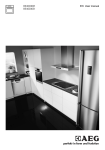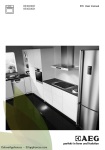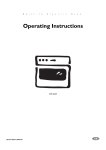Download EE1000001 EN User manual
Transcript
EE1000001 EN User manual 2 www.aeg.com CONTENTS 1. 2. 3. 4. 5. 6. 7. 8. 9. 10. SAFETY INFORMATION . . . . . . . . . . . . . . . . . . . . . . . . . . . . . . . . . . . . . . . . . . . . . . . . . . . . . . 3 SAFETY INSTRUCTIONS . . . . . . . . . . . . . . . . . . . . . . . . . . . . . . . . . . . . . . . . . . . . . . . . . . . . . . 4 PRODUCT DESCRIPTION . . . . . . . . . . . . . . . . . . . . . . . . . . . . . . . . . . . . . . . . . . . . . . . . . . . . . 6 BEFORE FIRST USE . . . . . . . . . . . . . . . . . . . . . . . . . . . . . . . . . . . . . . . . . . . . . . . . . . . . . . . . . . 6 DAILY USE . . . . . . . . . . . . . . . . . . . . . . . . . . . . . . . . . . . . . . . . . . . . . . . . . . . . . . . . . . . . . . . . . 7 USING THE ACCESSORIES . . . . . . . . . . . . . . . . . . . . . . . . . . . . . . . . . . . . . . . . . . . . . . . . . . . . 8 ADDITIONAL FUNCTIONS . . . . . . . . . . . . . . . . . . . . . . . . . . . . . . . . . . . . . . . . . . . . . . . . . . . . 9 HELPFUL HINTS AND TIPS . . . . . . . . . . . . . . . . . . . . . . . . . . . . . . . . . . . . . . . . . . . . . . . . . . . . 9 CARE AND CLEANING . . . . . . . . . . . . . . . . . . . . . . . . . . . . . . . . . . . . . . . . . . . . . . . . . . . . . . 18 WHAT TO DO IF… . . . . . . . . . . . . . . . . . . . . . . . . . . . . . . . . . . . . . . . . . . . . . . . . . . . . . . . . . 21 FOR PERFECT RESULTS Thank you for choosing this AEG product. We have created it to give you impeccable performance for many years, with innovative technologies that help make life simpler – features you might not find on ordinary appliances. Please spend a few minutes reading to get the very best from it. Visit our website for: Get usage advice, brochures, trouble shooter, service information: www.aeg.com Register your product for better service: www.aeg.com/productregistration Buy Accessories, Consumables and Original spare parts for your appliance: www.aeg.com/shop CUSTOMER CARE AND SERVICE We recommend the use of original spare parts. When contacting Service, ensure that you have the following data available. The information can be found on the rating plate. Model, PNC, Serial Number. Warning / Caution-Safety information General information and tips Environmental information Subject to change without notice. ENGLISH 3 1. SAFETY INFORMATION Before the installation and use of the appliance, carefully read the supplied instructions. The manufacturer is not responsible if an incorrect installation and use causes injuries and damages. Always keep the instructions with the appliance for future reference. 1.1 Children and vulnerable people safety WARNING! Risk of suffocation, injury or permanent disability. • This appliance can be used by children aged from 8 years and above and persons with reduced physical, sensory or mental capabilities or lack of experience and knowledge if they are supervised by an adult or a person who is responsible for their safety. • Do not let children play with the appliance. • Keep all packaging away from children. • Keep children and pets away from the appliance when it operates or when it cools down. Accessible parts are hot. • If the appliance has a child safety device, we recommend that you activate it. • Cleaning and user maintenance shall not be made by children without supervision. 1.2 General Safety • Internally the appliance becomes hot when in operation. Do not touch the heating elements that are in the appliance. Always use oven gloves to remove or put in accessories or ovenware. • Do not use a steam cleaner to clean the appliance. • Before maintenance cut the power supply. • Do not use harsh abrasive cleaners or sharp metal scrapers to clean the glass door since they can 4 www.aeg.com scratch the surface, which may result in shattering of the glass. • To remove the shelf supports first pull the front of the shelf support and then the rear end away from the side walls. Install the shelf supports in the opposite sequence. 2. SAFETY INSTRUCTIONS 2.1 Installation WARNING! Only a qualified person must install this appliance. • Remove all the packaging. • Do not install or use a damaged appliance. • Obey the installation instruction supplied with the appliance. • Always be careful when you move the appliance because it is heavy. Always wear safety gloves. • Do not pull the appliance by the handle. • The kitchen cabinet and the recess must have suitable dimensions. • Keep the minimum distance from the other appliances and units. • Make sure that the appliance is installed below and adjacent safe structures. • Parts of the appliance carry current. Close the appliance with furniture to prevent touching the dangerous parts. • The sides of the appliance must stay adjacent to appliances or to units with the same height. Electrical connection WARNING! Risk of fire and electrical shock. • All electrical connections should be made by a qualified electrician. • The appliance must be earthed. • Make sure that the electrical information on the rating plate agrees with the power supply. If not, contact an electrician. • Always use a correctly installed shockproof socket. • Do not use multi-plug adapters and extension cables. • Make sure not to cause damage to the mains plug and to the mains cable. Contact the Service or an electrician to change a damaged mains cable. • Do not let mains cables to come in touch with the appliance door, specially when the door is hot. • The shock protection of live and insulated parts must be fastened in such a way that it cannot be removed without tools. • Connect the mains plug to the mains socket only at the end of the installation. Make sure that there is access to the mains plug after the installation. • If the mains socket is loose, do not connect the mains plug. • Do not pull the mains cable to disconnect the appliance. Always pull the mains plug. • Use only correct isolation devices: line protecting cut-outs, fuses (screw type fuses removed from the holder), earth leakage trips and contactors. • The electrical installation must have an isolation device which lets you disconnect the appliance from the mains at all poles. The isolation device must have a contact opening width of minimum 3 mm. ENGLISH 2.2 Use WARNING! Risk of injury, burns or electric shock or explosion. • Use this appliance in a household environment. • Do not change the specification of this appliance. • Make sure that the ventilation openings are not blocked. • Do not let the appliance stay unattended during operation. • Deactivate the appliance after each use. • Be careful, when you open the appliance door while the appliance is in operation. Hot air can release. • Do not operate the appliance with wet hands or when it has contact with water. • Do not apply pressure on the open door. • Do not use the appliance as a work surface or as a storage surface. • Always keep the appliance door closed when the appliance is in operation. • Open the appliance door carefully. The use of ingredients with alcohol can cause a mixture of alcohol and air. • Do not let sparks or open flames to come in contact with the appliance when you open the door. • Do not put flammable products or items that are wet with flammable products in, near or on the appliance. WARNING! Risk of damage to the appliance. • To prevent damage or discoloration to the enamel: – Do not put ovenware or other objects in the appliance directly on the bottom. – Do not put aluminium foil directly on the bottom of the appliance. – do not put water directly into the hot appliance. – do not keep moist dishes and food in the appliance after you finish the cooking. 5 – be careful when you remove or install the accessories. • Discoloration of the enamel has no effect on the performance of the appliance. It is not a defect in the sense of the warranty law. • Use a deep pan for moist cakes. Fruit juices cause stains that can be permanent. 2.3 Care and Cleaning WARNING! Risk of injury, fire or damage to the appliance. • Before maintenance, deactivate the appliance and disconnect the mains plug from the mains socket. • Make sure the appliance is cold. There is the risk that the glass panels can break. • Replace immediately the door glass panels when they are damaged. Contact the Service. • Be careful when you remove the door from the appliance. The door is heavy! • Clean regularly the appliance to prevent the deterioration of the surface material. • Remaining fat or food in the appliance can cause fire. • Clean the appliance with a moist soft cloth. Only use neutral detergents. Do not use abrasive products, abrasive cleaning pads, solvents or metal objects. • If you use an oven spray, obey the safety instructions on the packaging. • Do not clean the catalytic enamel (if applicable) with any kind of detergent. 2.4 Internal light • The type of light bulb or halogen lamp used for this appliance, is only for household appliances. Do not use it for house lighting. WARNING! Risk of electrical shock. • Before replacing the lamp, disconnect the appliance from the power supply. 6 www.aeg.com • Only use lamps with the same specifications. 2.5 Disposal WARNING! Risk of injury or suffocation. • Disconnect the appliance from the mains supply. • Cut off the mains cable and discard it. • Remove the door catch to prevent children and pets to get closed in the appliance. 3. PRODUCT DESCRIPTION 1 2 3 4 5 6 2 1 Control panel 7 2 Lamps / symbols of the cooking zones 3 Knob for the oven functions 5 12 8 9 4 5 Knob for the temperature 6 Temperature lamp / symbol / indica- 3 tor 2 11 4 Power lamp / symbol 7 Knobs for the cooking zones 1 10 8 Heating element 9 Lamp 10 Bottom heat 11 Shelf support, removable 12 Shelf positions 3.1 Accessories Wire shelf For cookware, cake tins, roasts. Combi pan For cakes and biscuits. To bake and roast or as a pan to collect fat. 4. BEFORE FIRST USE WARNING! Refer to the Safety chapters. ENGLISH 4.1 Initial Cleaning • Remove all parts from the appliance. • Clean the appliance before first use. 7 Refer to chapter "Care and Cleaning". 5. DAILY USE WARNING! Refer to the Safety chapters. 5.1 Activating and deactivating the appliance 1. Turn the control knob for the oven functions to select an oven function. 2. Turn the control knob for the temperature to select a temperature. 3. To deactivate the appliance turn the control knobs for the oven functions and temperature to the off position. Knob symbol, indicator or lamp (depends on the model - refer to the product description): • The indicator comes on when the oven heats up. • The lamp comes on when the appliance operates. • The symbol shows whether the knob controls one of the cooking zones, the oven functions or the temperature. 5.2 Oven Functions Oven function Light Application To activate the lamp without a cooking function. Conventional Cooking To bake and roast on 1 shelf position. Top Heat Bottom Heat Grilling Fast Grilling To brown bread, cakes and pastries. To finish cooked dishes. To bake cakes with crispy or crusty bottoms and to preserve food. To grill flat food and to toast. To grill flat food in large quantities and to toast. 5.3 Cooking zones You can operate the hob with the knobs for the cooking zones. Refer to the hob user manual. Control knob The lamps / symbols of the cooking zones (refer to the chapter "Product description") show which zone you set. Function Keep warm setting 0 5.4 Hob cooking zones Off position 8 www.aeg.com Control knob 1-9 Function Heat settings (1 = lowest heat setting, 9 = highest heat setting) Operating the hob: 1. Turn the knob to a necessary heat setting. 2. To complete the cooking process, turn the knob to the off position. Automatic heat-up function Only applicable for hobs with the automatic heat-up function. To start the automatic heat-up: 1. Turn the knob for the cooking zone clockwise as far as possible (beyond the highest heat setting). 2. Immediately set the necessary heat setting. 3. To deactivate the function, turn the knob to the off position. The automatic heat-up function heats the cooking zone with full power for some time. 6. USING THE ACCESSORIES WARNING! Refer to the Safety chapters. 6.1 Inserting the oven accessories The deep pan and the wire shelf have side edges. These edges and the shape of the guide-bars are a special device to prevent the cookware from slipping. ENGLISH 9 Installing the wire shelf and the deep pan together Put the wire shelf on the deep pan. Push the deep pan between the guide-bars of one of the oven levels. 7. ADDITIONAL FUNCTIONS 7.1 Cooling fan When the appliance operates, the cooling fan activates automatically to keep the surfaces of the appliance cool. If you deactivate the appliance, the cooling fan can continue to operate until the appliance cools down. 8. HELPFUL HINTS AND TIPS 8.1 Examples of cooking applications for the hob The data in the table is for guidance only. Heat setting Use to: Time Hints 1 To keep cooked food warm. as required Put a lid on the cookware. 1-2 To make Hollandaise sauce, and to melt butter, chocolate and gelatine. 5 - 25 min Mix at intervals. 1-2 To solidify fluffy omelettes and baked eggs. 10 - 40 min Cook with a lid on. 2-3 To simmer rice and milk-based dishes, and to heat up readycooked meals. 25 - 50 min Add a minimum of two times as much liquid as rice. Stir milk dishes halfway through. 3-4 To steam vegetables, fish and meat. 20 - 45 min Add some tablespoons of a liquid. 10 www.aeg.com Heat setting Use to: Time Hints 4-5 To steam potatoes. 20 - 60 min Use a maximum of ¼ l water for 750 g of potatoes. 4-5 To cook larger quantities of food, stews and soups. 60 - 150 min Add a maximum of 3 l of a liquid to the ingredients. 6-7 To lightly fry escalopes, veal cordon bleu, cutlets, rissoles, sausages, liver, eggs, pancakes and doughnuts, and to cook roux. as required Turn halfway through. 7-8 To fry hash browns, loin steaks and steaks. 5 - 15 min Turn halfway through. 9 To boil large quantities of water, to cook pasta, to sear meat (goulash, pot roast) and to deep-fry chips. The temperature and baking times in the tables are guidelines only. They depend on the recipes and the quality and quantity of the ingredients used. 8.2 Baking General instructions • Your new oven can bake or roast differently to the appliance you had before. Adapt your usual settings (temperature, cooking times) and shelf positions to the values in the tables. • With longer baking times, you can deactivate the oven approximately 10 minutes before the end of the baking time and then use the residual heat. When you cook frozen food, the trays in the oven can twist during baking. When the trays become cold again, the distortions are gone. How to use the Baking Tables • The manufacturer recommends that you use the lower temperature the first time. • If you cannot find the settings for a special recipe, look for the one that is almost the same. • You can extend baking times by 10 – 15 minutes if you bake cakes on more than one level. • Cakes and pastries at different heights do not always brown equally at first. If this occurs, do not change the temperature setting. The differences equalize during the baking procedure. 8.3 Tips on baking Baking results Possible cause Remedy The bottom of the cake is not browned sufficiently. The shelf position is incorrect. Put the cake on a lower shelf. The cake sinks and becomes soggy, lumpy or streaky. The oven temperature is too high. The next time you bake, set a slightly lower oven temperature. ENGLISH Baking results 11 Possible cause Remedy The cake sinks and becomes soggy, lumpy or streaky. The baking time is too short. Set a longer baking time. You cannot decrease baking times by setting higher temperatures. The cake sinks and becomes soggy, lumpy or streaky. There is too much liquid in the mixture. Use less liquid. Be careful with mixing times, especially if you use a mixing machine. The cake is too dry. The oven temperature is too low. The next time you bake, set a higher oven temperature. The cake is too dry. The baking time is too long. The next time you bake, set a shorter baking time. The cake browns unevenly. The oven temperature is Set a lower oven tempertoo high and the baking ature and a longer baktime is too short. ing time. The cake browns unevenly. The mixture is unevenly distributed. Spread the mixture evenly on the baking tray. The cake is not ready in the baking time given. The oven temperature is too low. The next time you bake, set a slightly higher oven temperature. Baking in tins Type of baking Oven function Shelf position Temperature °C Time in min. Ring cake or brioche Conventional Cooking 1 160 - 180 50 - 70 Madeira cake / fruit cakes Conventional Cooking 1 150 - 170 70 - 90 Fatless sponge cake / Fatless sponge cake Conventional Cooking 2 160 - 180 30 - 45 Flan base short pastry Conventional Cooking 2 190 - 2101) 10 - 25 Flan base sponge mixture Conventional Cooking 2 170 - 190 20 - 25 Apple pie / Apple pie (2 tins Ø 20 cm, diagonally off set) Conventional Cooking 1 180 70 - 90 12 www.aeg.com Type of baking Oven function Shelf position Temperature °C Time in min. Savoury flan (e. g, quiche lorraine) Conventional Cooking 1 180 - 200 40 - 60 Cheesecake Conventional Cooking 1 160 - 180 60 - 90 1) Preheat the oven. Cakes / pastries / breads on baking trays Type of baking Oven function Shelf position Temperature °C Time in min. Plaited bread / bread crown Conventional Cooking 2 170 - 190 40 - 50 Christmas stollen Conventional Cooking 2 160 - 180 1) 50 - 70 Bread (rye bread): 1. First part of baking process. 2. Second part of baking process. Conventional Cooking 1 Cream puffs / eclairs Conventional Cooking 3 190 - 210 1) 20 - 35 Swiss roll Conventional Cooking 3 180 - 200 1) 10 - 20 Cake with crumble topping (dry) Conventional Cooking 3 150 - 160 20 - 40 Buttered almond cake / sugar cakes Conventional Cooking 3 190 - 210 1) 15 - 30 Fruit flans (made with yeast dough / sponge mixture)2) Conventional Cooking 3 170 35 - 50 Fruit flans made with short pastry Conventional Cooking 3 170 - 190 40 - 60 1. 2. 2301) 160 - 180 1. 2. 25 30 - 60 ENGLISH 13 Type of baking Oven function Shelf position Temperature °C Time in min. Yeast cakes with delicate toppings (e.g. quark,cream,c ustard) Conventional Cooking 3 160 - 180 1) 20 - 40 2) Conventional Cooking 1 180 - 200 1) 30 - 50 Pizza (thin crust) Conventional Cooking 1 220 - 250 1) 15 - 25 Unleavened bread Conventional Cooking 1 230 - 250 10 - 15 Tarts (CH) Conventional Cooking 1 210 - 230 35 - 50 Oven function Oven level Temperature °C Time in min. Short pastry biscuits Conventional Cooking 3 170 - 190 10 - 20 Short bread / Short bread / Pastry Stripes Conventional Cooking 3 160 1) 20 - 30 Biscuits made with sponge dough Conventional Cooking 3 170 - 190 20 - 30 Pastries made with egg white, meringues Conventional Cooking 3 80 - 100 120 - 150 Macaroons Conventional Cooking 3 120 - 130 30 - 60 Biscuits made with yeast dough Conventional Cooking 3 170 - 190 20 - 40 Puff pastries Conventional Cooking 3 190 - 210 1) 20 - 30 Rolls Conventional Cooking 3 190 - 2101) 10 - 25 Pizza (with a lot of topping) 1) Preheat the oven. 2) Use deep pan Biscuits Type of baking 14 www.aeg.com Type of baking Oven function Oven level Temperature °C Time in min. Conventional Cooking 3 170 1) 20 - 30 Oven function Shelf position Temperature (°C) Time (min) Pasta bake Conventional Cooking 1 180 - 200 45 - 60 Lasagne Conventional Cooking 1 180 - 200 35 - 50 Vegetables au gratin 1) Conventional Cooking 1 180 - 200 15 - 30 Baguettes topped with melted cheese 1) Conventional Cooking 1 200 - 220 15 - 30 Sweet bakes Conventional Cooking 1 180 - 200 40 - 60 Fish bakes Conventional Cooking 1 180 - 200 40 - 60 Stuffed vegetables Conventional Cooking 1 180 - 200 40 - 60 Small cakes / Small cakes (20 per tray) 1) Preheat the oven. Bakes and gratins table Dish 1) Preheat the oven. 8.4 Roasting • Use heat-resistant ovenware to roast (refer to the instructions of the manufacturer). • You can roast large roasting joints directly in the deep pan (if present) or on the wire shelf above the deep pan. • Roast lean meats in the roasting tin with the lid. This keeps the meat more succulent. • All types of meat that can be browned or have crackling can be roasted in the roasting tin without the lid. • We recommend that you cook meat and fish weighing 1 kg and above in the oven. • To prevent the meat juices or fat from burning onto the pan, put some liquid into the deep pan. • If necessary, turn the roast (after 1 / 2 2 / 3 of the cooking time). • Baste large roasts and poultry with their juices several times during roasting. This gives better roasting results. • You can deactivate the appliance approximately 10 minutes before the end of the roasting time, and use the residual heat. ENGLISH 15 8.5 Roasting with Conventional Cooking Beef Type of meat Quantity Pot roast Oven func- Shelf position tion Temperature (°C) Time (min) 1 - 1.5 kg Conventional Cooking 1 200 - 230 105 - 150 Roast beef or fillet: rare per cm of thickness Conventional Cooking 1 230 - 2501) 6-8 Roast beef or fillet: medium per cm of thickness Conventional Cooking 1 220 - 2301) 8 - 10 Roast beef or fillet: well done per cm of thickness Conventional Cooking 1 200 - 2201) 10 - 12 Temperature (°C) Time (min) 1) Preheat the oven. Pork Type of meat Quantity Shoulder, neck, ham joint 1 - 1.5 kg Conventional Cooking 1 210 - 220 90 - 120 1 - 1.5 kg Conventional Cooking 1 180 - 190 60 - 90 750 g - 1 kg Conventional Cooking 1 170 - 190 50 - 60 750 g - 1 kg Conventional Cooking 1 200 - 220 90 - 120 Temperature (°C) Time (min) Chop, spare rib Meat loaf Porkknuckle (precooked) Oven func- Shelf position tion Veal Type of meat Quantity Roast veal Knuckle of veal Oven func- Shelf position tion 1 kg Conventional Cooking 1 210 - 220 90 - 120 1.5 - 2 kg Conventional Cooking 1 200 - 220 150 - 180 16 www.aeg.com Lamb Type of meat Quantity Leg of lamb, roast lamb 1 - 1.5 kg Conventional Cooking 1 - 1.5 kg Conventional Cooking Saddle of lamb Oven func- Shelf position tion Temperature (°C) Time (min) 1 210 - 220 90 - 120 1 210 - 220 40 - 60 Temperature (°C) Time (min) Game Type of meat Quantity Oven func- Shelf position tion Saddle of hare, leg of hare up to 1 kg Conventional Cooking 1 220 - 240 1) 30 - 40 Saddle of venison 1.5 - 2 kg Conventional Cooking 1 210 - 220 60 - 90 Haunch of venison 1.5 - 2 kg Conventional Cooking 1 200 - 210 90 - 120 Temperature (°C) Time (min) 1) Preheat the oven. Poultry Type of meat Poultry portions Half chicken Chicken, poulard Quantity Oven func- Shelf position tion 200 - 250 g each Conventional Cooking 1 220 - 250 20 - 40 400 - 500 g each Conventional Cooking 1 220 - 250 35 - 50 1 - 1.5 kg Conventional Cooking 1 220 - 250 50 - 70 1.5 - 2 kg Conventional Cooking 1 210 - 220 80 - 100 3.5 - 5 kg Conventional Cooking 1 200 - 210 150 - 180 2.5 - 3.5 kg Conventional Cooking 1 200 - 210 120 - 180 Duck Goose Turkey ENGLISH Type of meat Quantity Turkey 4 - 6 kg Oven func- Shelf position tion Conventional Cooking 1 17 Temperature (°C) Time (min) 180 - 200 180 - 240 Temperature (°C) Time (min) 210 - 220 40 - 70 Fish Type of meat Quantity Whole fish 1 - 1.5 kg Oven func- Shelf position tion Conventional Cooking 1 Grill only flat pieces of meat or fish. Always preheat the empty oven with the grill functions for 5 minutes. 8.6 Grilling Always grill with the maximum temperature setting. Set the shelf into the shelf position as recommended in the grilling table. Always set the pan to collect the fat into the first shelf position. CAUTION! Always grill with the oven door closed. Grilling Food to be grilled Time (min.) Shelf position Temperature 1st side 2nd side Roast beef 2 210 - 230 30 - 40 30 - 40 Filet of beef 3 230 20 - 30 20 - 30 Back of pork 2 210 - 230 30 - 40 30 - 40 Back of veal 2 210 - 230 30 - 40 30 - 40 Back of lamb 3 210 - 230 25 - 35 20 - 25 Whole Fish, 500 - 1000 g 3/4 210 - 230 15 - 30 15 - 30 Fast Grilling Time (min.) Food to be grilled Shelf position 1st side 2nd side Burgers / Burgers 4 8 - 10 6-8 Pork fillet 4 10 - 12 6 - 10 Sausages 4 10 - 12 6-8 Fillet / Veal steaks 4 7 - 10 6-8 Toast / Toast 1) 5 1-3 1-3 Toast with topping 4 6-8 - 1) Preheat the oven. 18 www.aeg.com 8.7 Preserving - Bottom Heat Things to note: • Use only preserve jars of the same dimensions available on the market. • Do not use jars with twist-off and bayonet type lids or metal tins. • Use the first shelf from the bottom for this function. • Put no more than six one-litre preserve jars on the baking tray. • Fill the jars equally and close with a clamp. • The jars cannot touch each other. • Put approximately 1 / 2 litre of water into the baking tray to give sufficient moisture in the oven. • When the liquid in the jars starts to simmer (after approximately 35 - 60 minutes with one-litre jars), stop the oven or decrease the temperature to 100 °C (see the table). Soft fruit Preserve Temperature in °C Strawberries / Blueberries / Raspberries / Ripe gooseberries 160 - 170 Cooking time unContinue to cook til simmering at 100°C (min.) (min.) 35 - 45 - Stone fruit Preserve Pears / Quinces / Plums Temperature in °C Cooking time unContinue to cook til simmering at 100°C (min.) (min.) 160 - 170 35 - 45 10 - 15 Vegetables Preserve Temperature in °C Cooking time unContinue to cook til simmering at 100°C (min.) (min.) Carrots 1) 160 - 170 50 - 60 5 - 10 Cucumbers 160 - 170 50 - 60 - Mixed pickles 160 - 170 50 - 60 5 - 10 Kohlrabi / Peas / Asparagus 160 - 170 50 - 60 15 - 20 1) Leave standing in the oven after it’s deactivated. 9. CARE AND CLEANING WARNING! Refer to the Safety chapters. Notes on cleaning: • Clean the front of the appliance with a soft cloth with warm water and a cleaning agent. ENGLISH • To clean metal surfaces, use a usual cleaning agent. • Clean the appliance interior after each use. Then you can remove dirt more easily and it does not burn on. • Clean stubborn dirt with a special oven cleaner. • Clean all accessories after each use and let them dry. Use a soft cloth with warm water and a cleaning agent. 19 • If you have nonstick accessories, do not clean them using aggressive agents, sharp-edged objects or a dishwasher. It can cause damage to the nonstick coating. 9.1 Shelf supports Removing the shelf supports You can remove the shelf supports to clean the side walls. 1. Pull the front of the shelf support away from the side wall. 2. Pull the rear end of the shelf support away from the side wall and remove it. 2 1 Installing the shelf supports Install the shelf supports in the opposite sequence. Valid for telescopic runners: The retaining pins on the telescopic runners must point to the front. 9.2 Lamp WARNING! There is a risk of electrical shock. The lamp and the lamp glass cover can be hot. Before you change the lamp: • Deactivate the appliance. • Remove the fuses from the fuse box or deactivate the circuit breaker. CAUTION! Put a cloth on the bottom of the interior of the appliance. It prevents damage to the lamp glass cover and the cavity. Always use the same lamp type. Replacing the lamp at the cavity ceiling: 1. Turn the lamp glass cover counterclockwise to remove it. 2. Clean the glass cover. 20 www.aeg.com 3. Replace the lamp with a suitable 300 °C heat-resistant lamp. 4. Install the glass cover. 9.3 Oven ceiling You can fold down the heating element on the oven ceiling to clean the oven ceiling easily. WARNING! Deactivate the appliance before you fold down the heating element. Make sure that the appliance is cold. There is a risk of burns. 2. Hold the heating element with two hands at the front. 3. Pull it forwards against the spring pressure and out along the supports on the two sides. 4. The heating element folds down. You can clean the oven ceiling. Installing the heating element Install the heating element in the opposite sequence. 1. Install the heating element correctly above the supports on the inner walls of the appliance. 2. Install the shelf supports. Folding down the heating element Remove the shelf supports. 1. 9.4 Cleaning the oven door Removing the door and the glass panels You can remove the oven door and the internal glass panels to clean it. The number of glass panels is different for different models. WARNING! Be careful when you remove the door from the appliance. The door is heavy. 1. 2. A A Open the door fully. Fully press the clamping levers (A) on the two door hinges. 3. Close the oven door to the first opening position (approximately 70° angle). 4. Hold the door with one hand on each side and pull it away from the appliance at an up angle. ENGLISH 5. Put the door with the outer side down on a soft cloth on a stable surface. This is to prevent scratches. 6. Hold the door trim (B) on the top edge of the door at the two sides and push inwards to release the clip seal. Pull the door trim to the front to remove it. 2 7. B 21 1 8. 9. Installing the door and the glass panels Hold the door glass panels on their top edge one by one and pull them up out of the guide. Clean the glass panel with water and soap. Dry the glass panel carefully. the above steps in the opposite sequence. Install the smaller panel first, then the larger. When the cleaning is completed, install the glass panels and the oven door. Do 10. WHAT TO DO IF… WARNING! Refer to the Safety chapters. Problem Possible cause Remedy The cooking zones do not operate. Refer to the operating instructions for the built-in cooking surface. The appliance does not heat up. The appliance is deactivated. Activate the appliance. The appliance does not heat up. The fuse is released. Make sure that the fuse is the cause of the malfunction. If the fuse releases again and again, contact a qualified electrician. The lamp does not oper- The lamp is defective. ate. Replace the lamp. 22 www.aeg.com Problem Possible cause Remedy Steam and condensation You left the dish in the settle on the food and in appliance for too long. the cavity of the appliance. If you cannot find a solution to the problem yourself, contact your dealer or the service centre. The necessary data for the service centre is on the rating plate. The rating plate is Do not leave the dishes in the appliance for longer than 15 - 20 minutes after the cooking process ends. on the front frame of the appliance cavity. We recommend that you write the data here: Model (MOD.) ......................................... Product number (PNC) ......................................... Serial number (S.N.) ......................................... 11. ENVIRONMENT CONCERNS Recycle the materials with the symbol . Put the packaging in applicable containers to recycle it. Help protect the environment and human health and to recycle waste of electrical and electronic appliances. Do not dispose appliances marked with the symbol with the household waste. Return the product to your local recycling facility or contact your municipal office. ENGLISH 23 892956621-A-402012 www.aeg.com/shop
























